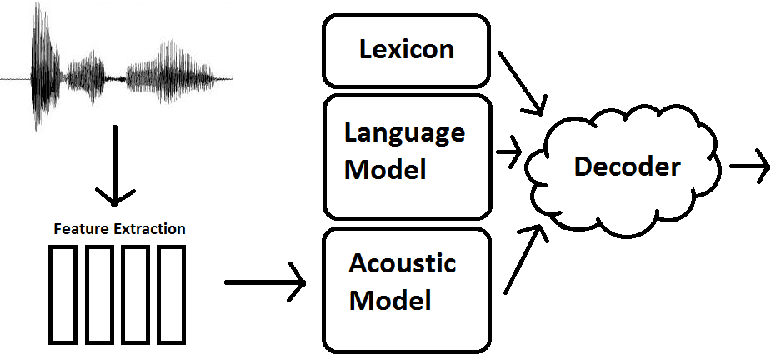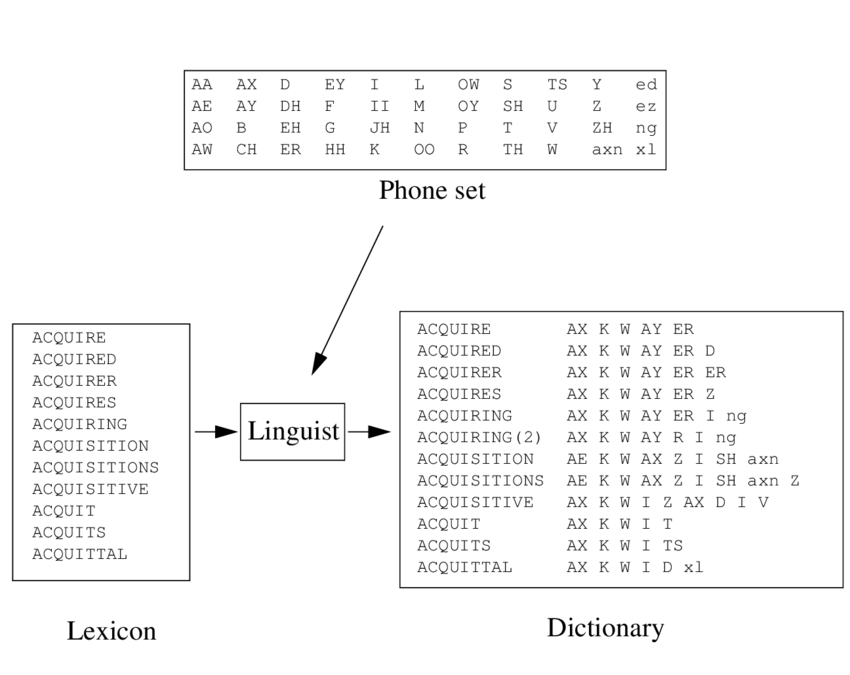Vosk: Difference between revisions
(Created page with "= Automatic speech recognition with Vosk¶ = Vosk is speech recognition software which translates speech into text, which is also called speech-to-text (or STT in short). The software is made by [https://alphacephei.com/en/#about-page Alpha Cephei] whose ''primary mission is scientific''. They release Vosk in 3 versions: Vosk open source, Vosk enterprise and Vosk mobile. As automatic speech recognition (ASR) is one of the su...") |
No edit summary |
||
| Line 1: | Line 1: | ||
= Automatic speech recognition with Vosk | = Automatic speech recognition with Vosk = | ||
Vosk is speech recognition software which translates speech into text, which is also called speech-to-text (or STT in short). | Vosk is speech recognition software which translates speech into text, which is also called speech-to-text (or STT in short). | ||
| Line 7: | Line 7: | ||
As automatic speech recognition (ASR) is one of the sub domains of the computational linguistics field, there is a whole range of software available to work with speech recognition, such as [https://cmusphinx.github.io/ CMU Sphinx] or [https://kaldi-asr.org/ Kaldi]. Vosk is particulary made to be used in a "plug and play" manner. Other software might provide many more options and ways to tweak how speech is recognised, but usually they are also much more difficult in their use. | As automatic speech recognition (ASR) is one of the sub domains of the computational linguistics field, there is a whole range of software available to work with speech recognition, such as [https://cmusphinx.github.io/ CMU Sphinx] or [https://kaldi-asr.org/ Kaldi]. Vosk is particulary made to be used in a "plug and play" manner. Other software might provide many more options and ways to tweak how speech is recognised, but usually they are also much more difficult in their use. | ||
== Encoding & Decoding | == Encoding & Decoding == | ||
[[File:asr2.png]] | [[File:asr2.png]] | ||
| Line 19: | Line 19: | ||
What is an '''acoustic model'''? ([http://www.voxforge.org/home/docs/faq/faq/what-is-an-acoustic-model source, and nice clear step-by-step description]) | What is an '''acoustic model'''? ([http://www.voxforge.org/home/docs/faq/faq/what-is-an-acoustic-model source, and nice clear step-by-step description]) | ||
> An acoustic model is a file that contains statistical representations of each of the distinct sounds that makes up a word. | <blockquote> | ||
An acoustic model is a file that contains statistical representations of each of the distinct sounds that makes up a word. | |||
</blockquote> | |||
What is a '''language model'''? ([http://www.voxforge.org/home/docs/faq/faq/what-is-a-language-model source]) | What is a '''language model'''? ([http://www.voxforge.org/home/docs/faq/faq/what-is-a-language-model source]) | ||
> A Statistical Language Model is a file used by a Speech Recognition Engine to recognize speech. It contains a large list of words and their probability of occurrence. | <blockquote> | ||
A Statistical Language Model is a file used by a Speech Recognition Engine to recognize speech. It contains a large list of words and their probability of occurrence. | |||
</blockquote> | |||
Example of a '''phonetic dictionary''': https://raw.githubusercontent.com/cmusphinx/cmudict/master/cmudict.dict ([https://github.com/cmusphinx/cmudict source]) | Example of a '''phonetic dictionary''': https://raw.githubusercontent.com/cmusphinx/cmudict/master/cmudict.dict ([https://github.com/cmusphinx/cmudict source]) | ||
| Line 29: | Line 33: | ||
[[File:phoneme-dict.png]] | [[File:phoneme-dict.png]] | ||
== How do the Vosk models decode speech? | == How do the Vosk models decode speech? == | ||
From https://alphacephei.com/vosk/lm: | From https://alphacephei.com/vosk/lm: | ||
> The knowledge representation in speech recognition is an open question. | <blockquote> | ||
The knowledge representation in speech recognition is an open question. | |||
</blockquote> | |||
> Traditionally Vosk models compile the following data sources to build recognition graph: | <blockquote> | ||
Traditionally Vosk models compile the following data sources to build recognition graph: | |||
* Acoustic model - model of sounds of the language | |||
* Language model - model of word sequences | |||
* Phonetic dictionary - model of the decomposition on words to sounds | |||
</blockquote> | |||
=== Install Vosk | == Using Vosk == | ||
=== Install Vosk == | |||
* you can install it using pip: <code>$ pip3 install vosk</code> | * you can install it using pip: <code>$ pip3 install vosk</code> | ||
* use it as a python library: <code>import vosk</code> | * use it as a python library: <code>import vosk</code> | ||
=== Install Vosk in a virtual environment (recommended) | === Install Vosk in a virtual environment (recommended) === | ||
* navigate to the folder you work in: <code>$ cd ~/my/current/folder/</code> | * navigate to the folder you work in: <code>$ cd ~/my/current/folder/</code> | ||
| Line 58: | Line 66: | ||
* you can only use vosk now with your virtual environment activated. So when you run a python script that uses vosk, you need to run <code>$ python3 myscript.py</code> while you are in this virtual environment. | * you can only use vosk now with your virtual environment activated. So when you run a python script that uses vosk, you need to run <code>$ python3 myscript.py</code> while you are in this virtual environment. | ||
=== Download a model | === Download a model === | ||
Before you can try to run Vosk, you need to do download a model: | Before you can try to run Vosk, you need to do download a model: | ||
| Line 71: | Line 79: | ||
** <code>NOTE:</code> this is the folder that Vosk will look for; it is important that your notebook/script and "model" folder are in the same place | ** <code>NOTE:</code> this is the folder that Vosk will look for; it is important that your notebook/script and "model" folder are in the same place | ||
=== Connect your mic | === Connect your mic === | ||
<code>REMEMBER:</code> you need a microphone to use Vosk, and the Soupboat does not have one (yet?)! | <code>REMEMBER:</code> you need a microphone to use Vosk, and the Soupboat does not have one (yet?)! | ||
| Line 77: | Line 85: | ||
So in order to work with Vosk, you need to work on a computer that has either a '''build-in microphone''', or is connected to an '''external microphone'''. | So in order to work with Vosk, you need to work on a computer that has either a '''build-in microphone''', or is connected to an '''external microphone'''. | ||
=== Start from examples | === Start from examples === | ||
There are multiple example scripts provided by the makers of Vosk, you can find them in their GitHub repository: https://github.com/alphacep/vosk-api/tree/master/python/example=== Start from a customized example | There are multiple example scripts provided by the makers of Vosk, you can find them in their GitHub repository: https://github.com/alphacep/vosk-api/tree/master/python/example=== Start from a customized example | ||
See <code>speech-to-text.py</code> for a script that we prepared for you, that takes '''speech as input''' and '''plain text as output'''. | See <code>speech-to-text.py</code> for a script that we prepared for you, that takes '''speech as input''' and '''plain text as output'''. | ||
Run it with: <code>$ python3 speech-to-text.py</code> | Run it with: <code>$ python3 speech-to-text.py</code> | ||
Revision as of 16:06, 2 September 2024
Automatic speech recognition with Vosk
Vosk is speech recognition software which translates speech into text, which is also called speech-to-text (or STT in short).
The software is made by Alpha Cephei whose primary mission is scientific. They release Vosk in 3 versions: Vosk open source, Vosk enterprise and Vosk mobile.
As automatic speech recognition (ASR) is one of the sub domains of the computational linguistics field, there is a whole range of software available to work with speech recognition, such as CMU Sphinx or Kaldi. Vosk is particulary made to be used in a "plug and play" manner. Other software might provide many more options and ways to tweak how speech is recognised, but usually they are also much more difficult in their use.
Encoding & Decoding
Automatic speech regonition is based on processes of encoding and decoding.
To do that, speech is encoded in multiple ways, which is a process that is also called knowledge representation. The output of this encoding process are models, such as: acoustic models, language models, lexicons, and phonetic dictionaries.
The speech recognition software uses these models to decode speech.
What is an acoustic model? (source, and nice clear step-by-step description)
An acoustic model is a file that contains statistical representations of each of the distinct sounds that makes up a word.
What is a language model? (source)
A Statistical Language Model is a file used by a Speech Recognition Engine to recognize speech. It contains a large list of words and their probability of occurrence.
Example of a phonetic dictionary: https://raw.githubusercontent.com/cmusphinx/cmudict/master/cmudict.dict (source)
How do the Vosk models decode speech?
From https://alphacephei.com/vosk/lm:
The knowledge representation in speech recognition is an open question.
Traditionally Vosk models compile the following data sources to build recognition graph:
- Acoustic model - model of sounds of the language
- Language model - model of word sequences
- Phonetic dictionary - model of the decomposition on words to sounds
Using Vosk
= Install Vosk
- you can install it using pip:
$ pip3 install vosk - use it as a python library:
import vosk
Install Vosk in a virtual environment (recommended)
- navigate to the folder you work in:
$ cd ~/my/current/folder/ - make a virtual environment:
$ python3 -m venv myvenv - activate your virtualenvironment:
$ source myvenv/bin/activate - now you should see that your prompt changed into something that looks like this:
$(myvenv) - install vosk:
$ pip3 install vosk - now vosk is installed in the folder:
myvenv/lib/python3.7/site-packages/vosk/ - you can only use vosk now with your virtual environment activated. So when you run a python script that uses vosk, you need to run
$ python3 myscript.pywhile you are in this virtual environment.
Download a model
Before you can try to run Vosk, you need to do download a model:
- choose a model: https://alphacephei.com/vosk/models
NOTE:check the filesize of the model, maybe you don't want to choose a big one if you use the soupboat
- download it to the soupboat (for example for the small EN-US model):
$ cd the/folder/that/you/are/working/in/$ wget https://alphacephei.com/vosk/models/vosk-model-small-en-us-0.15.zip$ unzip vosk-model-small-en-us-0.15.zip
- rename the folder into:
modelNOTE:this is the folder that Vosk will look for; it is important that your notebook/script and "model" folder are in the same place
Connect your mic
REMEMBER: you need a microphone to use Vosk, and the Soupboat does not have one (yet?)!
So in order to work with Vosk, you need to work on a computer that has either a build-in microphone, or is connected to an external microphone.
Start from examples
There are multiple example scripts provided by the makers of Vosk, you can find them in their GitHub repository: https://github.com/alphacep/vosk-api/tree/master/python/example=== Start from a customized example
See speech-to-text.py for a script that we prepared for you, that takes speech as input and plain text as output.
Run it with: $ python3 speech-to-text.py


